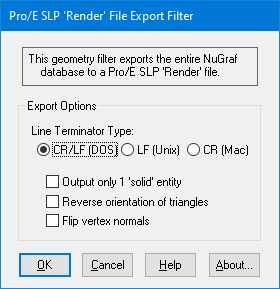| You are here: Home » Specialized Sections » How To: CAD to STL Conversions |
|
Please also refer to our ProE/Creo Solutions page and our "PTC Granite" suite of solids-based CAD importers. The complete set of importers is listed here, and exporters listed here. CAD program compatibility is listed here.
This export converter writes out the 3d database to an ASCII formatted 'SLP Render File' which can be read by such programs as PTC's ProE/Creo.
An object called 'test' containing a single red-colored triangle is written to the SLP file as follows:
solid test color 1 0 0 facet normal -0.142009 0.787792 -0.599347 normal -0.428189 0.118216 -0.895924 normal -0.141049 0.0691386 -0.987585 outer loop vertex 0.907193 -2.90889 0.550182 vertex 0.902064 -2.92802 0.550057 vertex 0.786019 -2.92854 0.601628 endloop endfacet end solid

The following information explains the various options on the dialog box:
Output Only 1 'Solid' Entity
If this option is enabled (checkmarked) then each object defined within the database will be output as a separate object in the SLP file (enclosed within its own 'solid' definition). If this option is disabled then all objects within the database will be compressed into a single entity before being output to the SLP file as a single 'solid' definition.Reverse Orientation of Triangles
If this option is enabled (checkmarked) then the orientation of all triangles will be reversed (this will effectively swap the orientation of the triangles' geometric normals). This option will not flip the orientation of the vertex normals.Flip Vertex Normals
If this option is enabled (checkmarked) then the orientation of each vertex normal will be reversed. You may need to enable this option if the SLP file looks 'dark' in the final destination rendering program.Line Terminator Type
This common option selects which line terminator is to be used for the ASCII output file:
- Files destined for DOS/PC machines should use CR/LF,
- Files for UNIX machines should use LF, and
- Files for Macintosh machines should use CR.
The default is specific to which machine this converter is presently running on: CRLF for DOS/PC, LF for UNIX and CR for Macintosh. This option normally does not have to be specified unless you will be using the exported ASCII file on a different type of computer.

